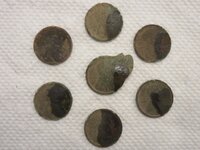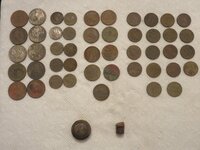against the wind
Gold Member
- Jul 27, 2015
- 24,797
- 24,977
- 🏆 Honorable Mentions:
- 1
- Detector(s) used
- E-trac, Excalibur, XP Deus, & CTX 3030.
- Primary Interest:
- All Treasure Hunting
I sneaked in a 3 hour hunt after work yesterday. I hit a park that has given up some Indian Head Pennies in the past. I'm using the CTX and I'm finding that it is giving up some different signals. (If not strange).
Normally I believe an Indian Head Penny will give you a signal that can range from 12-31 to 12-38. A wheat Penny will come in from 12-40 to
12-44. In this park the Indians will be at around 7 inches. Well, I dug 7 Wheat Pennies at 7 inches.
Yesterday I dug 7 separate wheat pennies that came in at 7 inches with target I.D. numbers in the 30's. Quite unusual. One penny is a 1920 and looks as if someone tried to stretch it's value. lol


Normally I believe an Indian Head Penny will give you a signal that can range from 12-31 to 12-38. A wheat Penny will come in from 12-40 to
12-44. In this park the Indians will be at around 7 inches. Well, I dug 7 Wheat Pennies at 7 inches.
Yesterday I dug 7 separate wheat pennies that came in at 7 inches with target I.D. numbers in the 30's. Quite unusual. One penny is a 1920 and looks as if someone tried to stretch it's value. lol


Amazon Forum Fav 👍
Upvote
6




